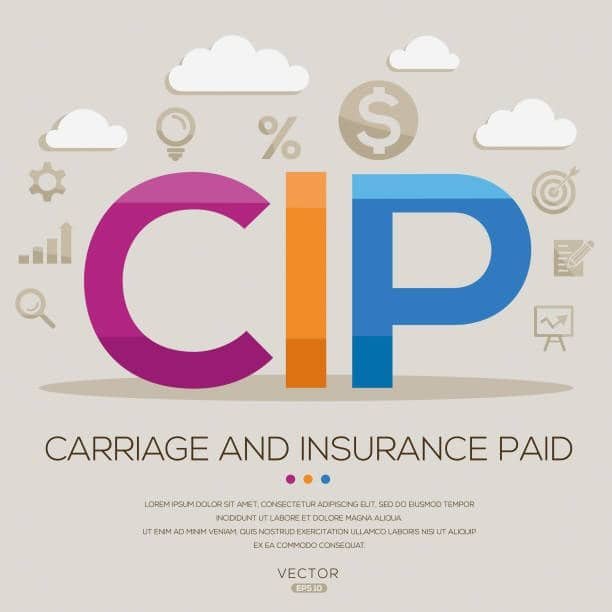Shipping terms are very important in the business operations of international trade, which is a very complex and sophisticated field. One of the most significant Incoterms is CIP (Carriage and Insurance Paid) which determines the details of the movement of goods, and who is responsible in case of any risks, and the transfer of the ownership regarding goods by the people buying and selling it. This guide is the most comprehensive guide on shipping term cip and CIP shipping terms that you can use to make informed decisions when transacting the global trade operations.
What is CIP in Shipping Terms?

CIP has a short name carriage and Insurance paid to and is one of the eleven Incoterms (International Commercial Terms) formulated by international chamber of commerce. With CIP terms, it is the seller who is expected to organize and bear the cost of the principal movement of goods to a specific named destination and also bear the nominal insurance coverage against risks of damages. Nonetheless, there is a balance of risks between parties in a trade that a shift of risk in the event of loss or damages shifts to a buyer after the goods have been delivered to the first carrier.
This shipping term is also very useful in international traffic when buyers desire to have a basic insurance cover but sellers also wish to have control over the movement plans. CIP offers flexibility and at the same time ensuring that goods are well protected, including through additional insurance in their quest to reach their market.
Key Responsibilities Under CIP Terms

When working with the CIP terms, it is crucial that one knows how the responsibilities are distributed. The seller should provide and bear the costs of transportation to the destination agreed, procure minimum insurance cover (usually 110 percent of the invoice value on Institute Cargo Clauses C or equivalent-type externally issued policies), to clear the goods through the exportation facilities as well as to transport them to the first carrier of the goods. Moreover, sellers are also expected to furnish essential documents such as transport documents, insurance policies and commercial invoices.
The import clearance is made by buyers who pay import duties and taxes involved, carry out transportation between the destination terminal and their physical destination and even assume the risk of losses or damages after delivery of goods to the first carrier. Such obvious distribution of responsibilities helps to avoid conflicts and makes the execution of transaction easy to perform.
CIP vs Other Incoterms: Understanding the Differences
The use of CIP is very different to other widely used Incoterms. In contrast with FOB (Free on Board) in which the seller requirements cease after delivering goods to the shipping port, CIP (Carriage and Insurance Paid to) also needs the seller to organize and pay to the final destination. As compared to CIF (Cost, Insurance and Freight) that is applicable in the case of sea deliveries, the CIP can be applicable on land, air transport and/or multimodal shipment.
In comparison with CPT (Carriage Paid To), the first distinction lies in the fact that the CIP type of a contract comes along with compulsory insurance cover whereas the latter, CPT, does not compel the seller to insure goods. In DAP (Delivered at Place), the obligation rests largely on the seller, who is required to deliver the goods to the premises of the buyer whereas in CIP the risk transfers and is shifted much earlier into the transportation process.
Risk Transfer and Insurance Coverage in CIP
Risk transfer is the other important feature in terms of CIP that can be rather confusing. Although the seller covers transportation and insurance costs to the destination, what happens is that the risk of loss or damage passes to the buyer upon delivery of goods to the first carrier. This implies that in case the goods are spoiled in transit, then the buyer is expected to make insurance claims yet it is the seller who bought the policy.
The CIP insurance requirement is the minimum cover which is normally an Institute Cargo Clauses C or comparable level of cover which amount is 110 percent of the CIF value. This simple cover protects only against high risks such as fire, explosion, vessel stranding and collision, whereas it does not cover theft, pilferage and small damages, which could be addressed by all risk insurance coverage . The purchasers can decide to buy other insurance to cover the comprehensive cover.
Documentation Requirements for CIP Shipments

To allow free flow of CIP shipments and a risk-free experience at the customs, it is essential that proper documentation is placed. Among the necessary documents, there should be a commercial invoice with the description of goods, their price, and their sale conditions, the documents like bills of lading or airway bills which prove the arrangements of shipment, and insurance certificates or policies that prove the compliance with the coverage.
Other documentations might have packing lists, certificate of origin, export license in cases where such is required, and inspection certificates of certain commodities. The exporter should furnish all the exportation documents whereas the importer has to concern himself with getting importation permits and authorization. Efficient
Cost Structure and Financial Implications
The structure of the cost under CIP terms provides an understanding during the business budgeting procedure and intelligent price decisions. The expenses incurred by sellers are value of product, packaging to export, loading charges, export clearance charges, the main transport costs, minimum premium rates on insurance and the cost of documents. These expenses normally find their way in the quoted selling price to the customer.
The import duties and taxes, import clearance fees, destination handling costs, onward cost of transport, and any other premiums that the buyer would like to provide an extra cover are the purchases of the buyers. Invisible costs can be in the way of demurrage cost due to late pick-up, cost of storage, and currency fluctuations which affect import duties when they are estimated at the time of clearance.
Best Practices for CIP Implementation
A number of critical aspects must be considered in order to have successful CIP implementation. The designated destination should be clearly stated in a contract and ideally to a particular terminal/facility and not a city name. Make sure that insurance covers the both sides and does not break the laws. Introduce a transparent channel of communication among the freight forwarders, the insurers and the customs brokers.
Frequent checking on the shipment made would serve in early realisation on any problem that will be affected and good record keeping of all the transactions will help in easy reaching of agreements in case some hitches occur. Total landed cost should be considered in CIP offers that includes all of the buyer requirements and as well the additional costs which might arise.
Common Challenges and How to Overcome Them
There are a number of problems that usually occur with CIP shipments. The process of insurance claims may be complicated, particularly, in the cases where the buyers have to deal with policies acquired by the sellers. Claim processing can be hampered by language barriers as well as various legal systems. The answers to address these challenges should include setting up a system of effective insurance claims prior to shipment, keeping entries of condition of goods and handling, and employment of experienced freight forwarders conversant with CIP terms.
Failure to match the documentations usually leads to delays and extra expenses. Avoid these by setting up exhaustive documentation checklists, reviewing all documents carefully prior to shipment and retaining close contact with all those involved in the transaction.
Technology and Digital Solutions for CIP Management
There are only many solutions found in modern technology to make shipment of CIPs run smooth. Virtual systems offer the ability to track in real time, automatic processing of documentation, and built-in insurance management systems. The electronic bills of lading and computerized certificate lessen the processing time and errors brought by the paper-based system.
The blockchain technology is becoming a response to the challenges related to distributed documentation and improves the tracking of shipment due to the presence of artificial intelligence enhancing interception and planning of possible disturbances. Such technological innovations increase efficiency, lower expenses, and create visibility along the shipping method.
Regulatory Compliance and Legal Considerations
CIP shipments have to be according to several international and domestic regulations. May be the control in exporting may be restricted depending on the goods or the destinations of the foreign country, in the process of importing there is also a great difference in various countries. It is necessary to learn about the trade agreements likely to be applied, sanctions, and security requirements necessary to comply.
The companies should use qualified customs brokers and freight forwarders to facilitate regulatory compliance to prevent exorbitant fines buyer’s premises. The continuous development of regulations and profound adherence to the procedures assure businesses against legal and financial risks involved in international trade.
Industry-Specific Applications of CIP
There is a difference in the use of CIP terms as used in the various industries as the requirements are different. CIP is frequently used by manufacturing companies by sending regular shipment of raw materials or components because it offers predictability of transportation costs with partial risk transfer benefits. CIP is utilized by retail business when it seeks to import consumer goods especially with situations where it has several suppliers who are able to organize an effective transportation process.
Electronics and machinery consignments of high value are commonly covered under cargo insurance and CIP terms since insurance is required to buyer’s country, which gives necessary coverage whereas the seller has transport arrangements which usually yields a better rate due to volume deals. Perishable goods and agricultural foodstuff can apply CIP where there is a need to have a temperature-controlled transportation system and handling.
Future Trends in CIP Shipping
The maritime business is still developing since new transportation technologies and the trends in trade are appearing. This may change CIP cost structures and routing choices as a result of the rise in sustainability issues leading towards greener forms of transportation. Technological advancement is making documentation process easier and enhancing transparency in CIP transactions and buyer’s risk buyer’s responsibility. Transformational CIP deals are being carried out with efficiency and safety due to trade digitization endeavors such as electronic bills of lading, and smart contracts. The emerging focus on the resilience of the supply chain can give rise to more advanced insurance and risk management products, applied to CIP shipments inland waterway transport.
Choosing the Right Freight Forwarder for CIP
The process of choosing a proper freight forwarder is a key ingredient towards successful CIP implementation. Consider providers that have acquired vast experience in your trade lanes and type of merchantable commodities, thorough understanding of insurance expertise and intensive ties with carriers and insurers freight and insurance costs. A lot of useful technologies such as tracking systems, electronic documentation, etc. are becoming more pertinent to the effective activity.
The example of other professional logistic service companies capable of handling CIP should be Shenzhen Guanwutong International Freight Forwarding Co., Ltd. (GWT Worldwide). GWT world wide being a boutique player in freight forwarding services and supply chain solutions business deals and provides all encompassing services such as airfreight, sea freight, china to Europe rail freight services, and customs clearance. With high-level logistics technology, a world-wide network of reliable partners and a level of efficiency, transparency, and customer satisfaction, their work guarantees the safe and lawful transfer of goods according to CIP terms buyer appointed party.
Conclusion
The CIP shipping terms present a middle ground between parties in international trade since it is a selling method that offers the buyer the protection of transportation and insurance as well as the passing of risk quite early along the route. The study of the duties, expenses, and processes of CIP are critical in the opening up of international businesses successfully. Through best practices, technological leverage and cooperation with experienced logistical partners, any business can successfully use CIP terms to streamline its global trade operations, including managing freight costs and have the risk and cost calculus in perspective.


Thank you for reading!
Have questions, corrections, or better ideas? We’d love to hear from you!
We value every piece of feedback and promise to reply within 24 hours. Let's make this guide better together!
Note: Spam comments will not be published.